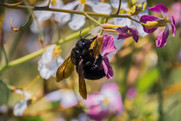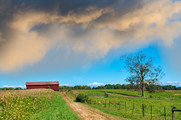|
Having trouble viewing this email? View it as a Web page.

|
|
|
Fresh From the Field is a weekly album showcasing transformative impacts made by partners supported by the National Institute of Food and Agriculture.
Editor: Falita Liles June 20, 2019
|
|
Success Stories

University of New Hampshire Research Supports Granite State’s Native Bees
Bees are essential for most of the fruit and vegetable crops produced in New England. The value of pollination to agriculture is estimated at more than $200 billion a year worldwide. However, the abundance of and diversity of pollinators are declining in landscapes across the United States.
At the New Hampshire Agricultural Experiment Station at the University of New Hampshire (UNH), scientists are conducting research that not only assesses the state of native bees but also developing ways that citizens can help support these important members of our ecological and agricultural communities.
Experiment station researchers have been assessing the status of the state’s native pollinators. In the first-ever assessment of New Hampshire’s bee population, scientists found that the Granite State has more than 100 native bees. They even discovered nearly 20 bee species that had not been previously documented in the state. The White Mountain National Forest alone is home to nearly 140 species of native bees, including two species of native bumble bees that are in decline in the Northeast.
Read the article at UNH.
|
Library

Pollen Collected By U.S. Honey Bees in Urban Settings Show Dramatic Seasonal Variation
The diversity and availability of pollen foraged by honey bees across urban and suburban areas in the United States varies drastically with the seasons, according to a study published June 12, 2019, in PLOS ONE by Juliana Rangel from Texas A&M University and colleagues.
Honey bee (Apis mellifera) colonies require a diversity of protein-rich pollen in order to rear healthy brood and ensure colony survival. During certain seasons, insufficient or poor-quality pollen can limit brood nutrition. In this study, the authors investigated the variation in pollen collected by honey bees across developed landscapes in California, Michigan, Florida, and Texas over the seasons of the year.
The authors tracked 394 sites with at least two hives each in urban and suburban locations. They placed a pollen trap at each hive entrance, which passively collected pollen from foraging bees and sampled it. The researchers used a light microscope to identify pollen grains to the family, genus, and species level where possible.
NIFA supported this project with funding from the Hatch Multistate and the Agriculture and Food Research Initiative.
|
Tweet of the Week
#NIFAIMPACTS

|
|

NIFA’s mission is to invest in and advance agricultural research, education, and extension that solve societal challenges. NIFA’s investments in transformative science directly support the long-term prosperity and global preeminence of U.S. agriculture. To learn more about NIFA’s impact on agricultural sciences, visit www.nifa.usda.gov/Impacts, sign up for email updates or follow us on Twitter @USDA_NIFA, #NIFAImpacts.
USDA is an equal opportunity lender, provider, and employer.
|
|